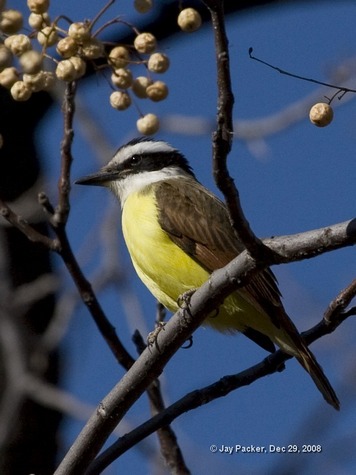 The Great Kiskadee (Pitangus sulphuratusis) a large (8.8 in. long, weight 2.2 oz.) tyrant flycatcher. It breeds in open woodlands with some tall trees, including cultivation and around human habitation, from southern Texas and Mexico to Uruguay and central Argentina, and on to Trinidad.
The Great Kiskadee (Pitangus sulphuratusis) a large (8.8 in. long, weight 2.2 oz.) tyrant flycatcher. It breeds in open woodlands with some tall trees, including cultivation and around human habitation, from southern Texas and Mexico to Uruguay and central Argentina, and on to Trinidad.
An adult Great Kiskadee has a stout black bill. The head is black with a strong white stripe above the eye and with a white chin, and with a concealed yellow crown stripe. The bird “reveals” this yellow crown stripe to look like a crest when challenging or when courting. The wings, back and tail are brown with strong rufous fringes. Its flashy bright yellow belly and shrill, exuberant call (kis-ter-DEE) along with the head and body colors make the Great Kiskadee easy to identify.
The nest, built by both sexes, usually in a tree or on a telephone pole, is a shaggy ball of twigs with a carefully constructed smooth round side entrance and smooth nest cup. The typical clutch is two to three cream eggs lightly blotched with reddish brown. They are incubated by the female. Both parents feed the babies.
They eat insects caught in flight, small rodents, fruit and berries, dog food, and they fish for and eat fish. from Wikipedia–Great Kiskadee
Abilene Sightings On March 16, 2010, a Great Kiskadee was sighted on Cedar Creek in Will Hair Park in northeast Abilene. This species normally breeds and lives in the far south Rio Grande Valley, Mexico, and points south. One individual (or individuals) seems to prefer the Cedar Creek area of Abilene. Several questions remain unanswered. Is this the same bird that was here several times in the past including in September and December of 2006; in April of 2008 and 2009, and again this year on March 16? Or, are there different birds? Or, does the bird reside here all year? We have only seen one bird at a time. We have heard it call numerous times. We need your help to answer these questions. This bird is easy to I.D. Please report any sightings with date, location, (picture if possible), your name and phone number to bigcountryaudubon@live.com or call a BCAS member. We will appreciate your help in answering these questions. Thanks. Katharine Hampton
ALERT: Be on the lookout for the TRUE sign that spring is here– a sighting of The Scissor-tailed Flycatcher. How exciting that will be!